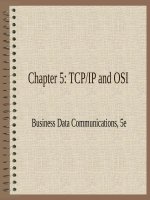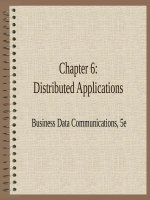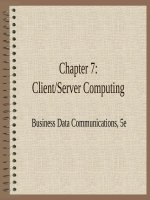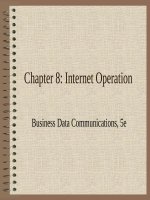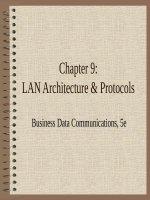Business data communications 5e by stallings chapter 13
Bạn đang xem bản rút gọn của tài liệu. Xem và tải ngay bản đầy đủ của tài liệu tại đây (202.29 KB, 25 trang )
Chapter 13:
Frame Relay & ATM
Business Data Communications, 5e
WAN Alternatives
Business Data Commun
ications, 5e
2
WAN Alternatives
(US Pricing)
QuickTime™ and a
TIFF (LZW) decompressor
are needed to see this picture.
Business Data Commun
ications, 5e
3
Integrated Network Access
Using Dedicated Channels
Business Data Commun
ications, 5e
4
Integrated Network Access
Using Public Switched WAN
Business Data Commun
ications, 5e
5
Frame Relay Characteristics
• Designed to eliminate excessive X.25 overhead
• Control signaling takes place on a separate
logical connection (nodes don’t need state tables
for each call)
• Multiplexing/switching take place at layer 2,
eliminating a layer of processing
• No hop-by-hop flow/error control
Business Data Commun
ications, 5e
6
Key Differences Between
Frame Relay and X.25
• Call control signaling is carried on a separate
logical connection from user data.
• Multiplexing and switching of logical
connections takes place at layer 2 instead of layer
3, eliminating one entire layer of processing
• No hop-by-hop flow control and error control.
End-to-end flow control and error control are the
responsibility of a higher layer, if employed at all.
Business Data Commun
ications, 5e
7
Frame Relay vs. X.25
• Reliability
– Frame relay loses ability to do link-by-link flow and error
control.
– X.25 link level protocol provides reliable hop-by-hop link control
– With increasing reliability of transmission and switching
facilities, this is not a major disadvantage.
• Streamlining
– Frame relay reduces need for protocol functionality at the usernetwork interface, and reduces internal network processing
– Improvement in throughput using frame relay, compared to X.25,
of an order of magnitude or more
Business Data Commun
ications, 5e
8
Frame Relay Architecture
Business Data Commun
ications, 5e
9
Frame Relay Control Plane
• Similar to common channel signaling, in that a
separate logical channel is used for control
information.
• At the data link layer, LAPD (Q.921) provides a
reliable data link control service, with error
control and flow control, between user (TE) and
network (NT).
• This data link service is used for the exchange of
Q.933 control signaling messages.
Business Data Commun
ications, 5e
10
Frame Relay User Plane
• User-plane protocol is LAPF (Link Access Procedure
for Frame Mode Bearer Services), defined in Q.922
• Core functions of LAPF are used for frame relay:
–
–
–
–
Frame delimiting, alignment, and transparency
Frame multiplexing/demultiplexing using address field
Inspection of frame contents
Inspection of the frame to ensure that it is neither too long
nor too short
– Detection of transmission errors
– Congestion control functions
Business Data Commun
ications, 5e
11
LAPF-Core Formats
Business Data Commun
ications, 5e
12
User Data Transfer
• No control field; connection mgt must be carried
out on a separate channel, and there is no flow or
error control
• Flag and frame check sequence (FCS) fields
function as in HDLC.
• Information field carries higher-layer data
• Address field length determined by the address
field extension (EA) bits
Business Data Commun
ications, 5e
13
Frame Relay Call Control
• Establish a logical connection between two
endpoints, and assign a unique DLCI to the
connection
• Exchange information in data frames. Each frame
includes a DLCI field to identify the connection
• Release the logical connection
Business Data Commun
ications, 5e
14
Frame Relay Congestion Control
• Two strategies supported in frame relay
– Congestion avoidance procedures are used at
the onset of congestion to minimize the effect
on the network
– Congestion recovery procedures are used to
prevent network collapse in the face of severe
congestion
Business Data Commun
ications, 5e
15
Operation of the CIR
Business Data Commun
ications, 5e
16
Asynchronous Transfer Mode
(ATM)
• Also known as cell relay
• Faster than X.25, more streamlined than frame
relay
• Supports data rates several orders of magnitude
greater than frame relay
• Data on logical connection is organized into
fixed-size packets, called cells.
• No link-by-link error control or flow control.
Business Data Commun
ications, 5e
17
Virtual Channels & Virtual Paths
• Logical connections in ATM are virtual channels
– analogous to a virtual circuit in X.25 or a frame relay
logical connection
– used for connections between two end users, usernetwork exchange (control signaling), and networknetwork exchange (network management and routing)
• A virtual path is a bundle of virtual channels that
have the same endpoints.
Business Data Commun
ications, 5e
18
Advantages of Virtual Paths
• Simplified network architecture
• Increased network performance and reliability
• Reduced processing and short connection setup
time
• Enhanced network services
Business Data Commun
ications, 5e
19
Virtual-Path/Virtual-Channel
Characteristics
• Quality of service
• Switched and semi-permanent virtual-channel
connections
• Cell sequence integrity
• Traffic parameter negotiation and usage
monitoring
Business Data Commun
ications, 5e
20
ATM Control Signaling:
Virtual Paths
• Semipermanent virtual channels may be used
for user-to-user exchange; no control signaling is
required.
• Meta-signaling channel, a permanent low-datarate channel used for a virtual channel that can be
used for call control
– user-to-network signaling virtual channel can than be
used to set up virtual channels to carry user data
– can also be used to set up a user-to-user signaling
virtual channel within a preestablished virtual path
Business Data Commun
ications, 5e
21
ATM Control Signaling:
Virtual Paths
• A virtual path can be established on a
semipermanent basis by prior agreement. No control
signaling is required.
• Establishment/release may be customer controlled.
Customer uses a signaling virtual channel to request
the virtual path from the network.
• Establishment/release may be network controlled.
Network establishes a virtual path (may be networkto-network, user-to-network, or user-to-user)
Business Data Commun
ications, 5e
22
ATM Cell Format
Business Data Commun
ications, 5e
23
ATM Cell Fields
•
•
•
•
•
•
Generic Flow Control (GFC) is used for control of cell flow only at
the local user-network interface, to alleviate short-term overload
conditions in the network.
Virtual Path Identifier (VPI) field constitutes a routing field for the
network.
Virtual Channel Identifier (VCI) field is used for routing to and from
the end user.
Payload Type (PT) field indicates the type of information in the
information field.
Cell loss priority (CLP) bit is used to provide guidance to the
network in the event of congestion.
Header Error Control (HEC) field is used to correct and detect errors
in the header
Business Data Commun
ications, 5e
24
ATM Service Categories
• Real-Time Service
– Constant bit rate (CBR)
– Real-time variable bit rate (rt-VBR)
• Non-Real-Time Service
– Non-real-time variable bit rate (nrt-VBR)
– Available bit rate (ABR)
– Unspecified bit rate (UBR)
– Guaranteed frame rate (GFR)
Business Data Commun
ications, 5e
25





